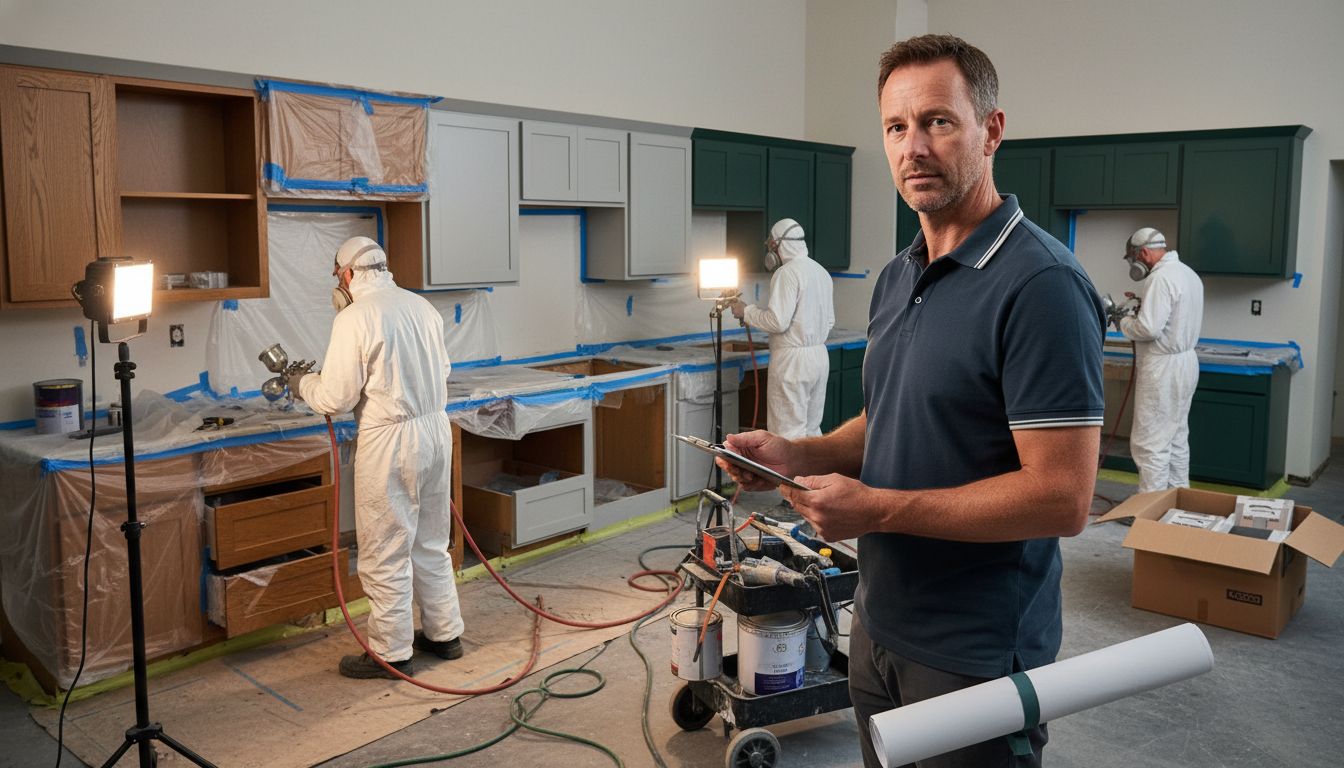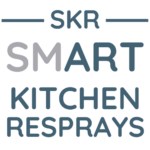Kitchen Respray for Property Developers: Complete Guide
Property developers seeking fast transformations know that a brand new kitchen can quickly eat up renovation budgets. In fact, kitchen respraying can cut costs by up to 70 percent compared to full replacement. Old cabinets do not have to mean outdated style. With the right technique, developers can refresh tired kitchens in just days and make any property more appealing. Discover how this method saves money, reduces disruption, and delivers impressive results for modern projects.
Table of Contents
- What Is Kitchen Respray for Developers?
- Common Kitchen Respray Types and Techniques
- Step-By-Step Kitchen Respray Process Explained
- Benefits of In-Situ Kitchen Respraying
- Risks, Costs, and Mistakes to Avoid
Key Takeaways
| Point | Details |
|---|---|
| Cost Efficiency | Kitchen respraying is a cost-effective alternative to full kitchen replacement, significantly reducing renovation expenses. |
| Minimal Disruption | The process minimizes disruption, allowing property developers to update kitchens without removing units or halting ongoing projects. |
| Rapid Turnaround | The kitchen respray process typically takes 1-2 days, enabling swift transformations for faster property turnover. |
| Potential for Increased Value | A freshly resprayed kitchen can enhance the property’s market appeal and overall value without substantial investment. |
What Is Kitchen Respray for Developers?
A kitchen respray is a professional renovation technique that allows property developers to transform existing kitchen surfaces without complete replacement. Instead of ripping out entire kitchen units, developers can refresh and modernise kitchens by applying specialised paint directly onto existing cabinet doors, worktops, and other surfaces.
This cost-effective method involves thoroughly cleaning, preparing, and respraying kitchen components using high-quality, durable paint specifically designed for kitchen environments. The process can dramatically change a kitchen’s aesthetic, making older properties more attractive to potential buyers or tenants without the significant expense and disruption of a full kitchen renovation. Kitchen Respray Best Practices guide provides comprehensive insights into this innovative approach.
For property developers, kitchen respraying offers several strategic advantages:
- Significantly lower cost compared to full kitchen replacement
- Minimal disruption to property renovation timelines
- Ability to quickly update multiple properties
- Environmentally friendly alternative to discarding existing kitchen units
- Potential to increase property market value with a fresh, modern appearance
The process typically involves multiple precise steps, including surface preparation, primer application, colour selection, and professional spray painting techniques. Skilled technicians use specialized equipment to ensure a smooth, factory-like finish that can withstand daily kitchen use and moisture exposure. By choosing kitchen respray, developers can transform tired, outdated kitchens into contemporary spaces that appeal to modern buyers and renters.
Common Kitchen Respray Types and Techniques
Property developers have several distinct kitchen respray techniques available, each tailored to different surface types and aesthetic goals. The primary approaches include cabinet door respraying, worktop refinishing, and complete kitchen unit transformation. Kitchen Painting vs Kitchen Spraying Explained provides detailed insights into these nuanced techniques.
The most common kitchen respray methods encompass:
- Spray Painting: Using professional-grade spray equipment to apply an even, factory-like finish
- Roller Application: Suitable for larger surface areas with less intricate details
- Brush Technique: Ideal for detailed work and precision edges
- Specialist Coating: Advanced technique using industrial-grade paint systems
Each technique requires specific preparation and skill. Professional kitchen resprayers begin with thorough surface cleaning, followed by careful sanding and priming to ensure paint adhesion. They typically use specialist equipment like high-volume, low-pressure (HVLP) spray guns that deliver a smooth, durable finish. These techniques allow developers to completely transform kitchen aesthetics without the substantial cost and disruption of full replacement.

The choice of technique depends on multiple factors including surface material, desired finish, kitchen usage, and budget. Ceramic, laminate, wood, and metal surfaces each respond differently to respraying techniques. For instance, wooden surfaces might require more extensive preparation compared to laminate, while high-traffic kitchen environments demand more robust paint systems that can withstand frequent cleaning and potential moisture exposure.
Step-By-Step Kitchen Respray Process Explained
The kitchen respray process is a meticulous transformation that requires precision, skill, and systematic approach. Property developers must follow a comprehensive sequence of steps to ensure a flawless, professional finish. Kitchen Unit Painting Tutorial for a Flawless Finish offers an in-depth walkthrough of this intricate process.
Here’s a detailed breakdown of the professional kitchen respray workflow:
- Initial Assessment and Preparation
- Conduct thorough surface inspection
- Identify material types and existing surface conditions
- Determine appropriate preparation techniques
- Select compatible paint systems
- Surface Preparation
- Deep clean all surfaces to remove grease, dirt, and contaminants
- Sand surfaces to create optimal paint adhesion
- Repair any minor damages or imperfections
- Apply high-quality primer suitable for specific surface material
- Protection and Masking
- Cover surrounding areas and appliances
- Use professional-grade masking tape and plastic sheeting
- Ensure complete workspace protection
- Create controlled painting environment
The actual respraying requires professional-grade equipment like high-volume, low-pressure (HVLP) spray guns, which deliver an even, smooth finish. Skilled technicians apply multiple thin layers, allowing proper drying between coats to achieve a factory-like result. Each layer is carefully applied to ensure uniform coverage, colour consistency, and durability.
The final stages involve detailed inspection, touch-ups, and quality control. Experienced professionals understand that successful kitchen respraying is not just about applying paint, but creating a transformative finish that meets property developers’ exacting standards. The entire process typically takes 1-2 days, depending on kitchen size and complexity, offering a rapid and cost-effective alternative to full kitchen replacement.
Benefits of In-Situ Kitchen Respraying
In-situ kitchen respraying offers property developers a revolutionary approach to kitchen renovation that minimizes disruption while maximizing aesthetic and financial value. Complete Guide to Why Respray Kitchen Doors highlights the strategic advantages of this transformative technique for property professionals.
The primary benefits for property developers include:
- Cost Efficiency: Significantly lower expenses compared to full kitchen replacement
- Minimal Disruption: No need to remove kitchen units or completely halt property development
- Rapid Transformation: Complete kitchen makeover achievable within 1-2 days
- Sustainability: Reduces waste by repurposing existing kitchen infrastructure
- Increased Property Value: Modernizes kitchen appearance without substantial investment
In-situ respraying allows developers to breathe new life into dated kitchens without the extensive time, cost, and logistical challenges associated with complete renovations. The process involves professional-grade painting directly applied to existing surfaces, creating a factory-fresh finish that can dramatically improve a property’s market appeal. Skilled technicians can match colours, update styles, and resolve surface imperfections, effectively resetting the aesthetic clock on kitchen units.
Moreover, this approach provides remarkable flexibility for property developers. Whether preparing a rental property for new tenants, staging a home for sale, or refreshing a portfolio of investment properties, in-situ kitchen respraying offers a swift, cost-effective solution. The technique transforms tired, outdated kitchens into contemporary spaces that attract potential buyers or renters, ultimately supporting faster property turnover and improved return on investment.
Risks, Costs, and Mistakes to Avoid
Property developers must carefully navigate the potential pitfalls of kitchen respraying to ensure successful project outcomes. Cost of Kitchen Respraying Explained: UK Cost Guide provides critical insights into the financial considerations and potential risks associated with this renovation technique.
Common mistakes and risks property developers should be aware of include:
- Poor Surface Preparation: Inadequate cleaning or sanding leading to paint adhesion failure
- Incorrect Paint Selection: Using incompatible paint systems for specific surface materials
- Budget Miscalculation: Underestimating total project costs and potential additional repairs
- Inexperienced Professionals: Hiring unqualified technicians resulting in substandard finishes
- Overlooking Hidden Damages: Failing to identify and address underlying surface issues
Cost considerations are crucial for property developers. The typical kitchen respray project can range from £500 to £2,500, depending on kitchen size, complexity, and surface condition. Unexpected expenses can arise from necessary repairs, premium paint systems, or additional preparation work. Professional developers should allocate a contingency budget of 15-20% above the initial quote to accommodate potential complications.
The most significant risks involve long-term durability and aesthetic outcomes. Improper application can result in premature paint failure, visible brush marks, uneven coverage, or rapid deterioration under daily kitchen use. Experienced property developers mitigate these risks by thoroughly vetting professional respraying services, requesting comprehensive portfolio reviews, and insisting on detailed warranties that cover material and workmanship quality.
 Cutting corners on kitchen respraying can ultimately cost more in future repairs or complete replacements.
Cutting corners on kitchen respraying can ultimately cost more in future repairs or complete replacements.
Transform Your Property Developments with Expert Kitchen Resprays
Facing the challenge of modernising tired kitchens while managing costs and timelines can be daunting. This guide highlights how in-situ kitchen respraying offers property developers a cost-effective, rapid way to update kitchen units without the disruption of full replacements. By focusing on precise surface preparation and professional spray techniques, you can increase property value and appeal with minimal fuss.

Ready to revitalise your kitchens with a smooth, factory-like finish that lasts? Our professional kitchen respray service specialises in exactly this transformation. Discover how our expert team can help you achieve stunning results while sticking to your schedule. Explore more about the process and benefits in our Uncategorized Archives and visit our main site at SKR Specialists for a tailored consultation. Don’t let outdated kitchens hold back your property’s potential – get in touch today and make your developments stand out.
Frequently Asked Questions
What is kitchen respray?
A kitchen respray is a professional technique that allows property developers to refresh and modernise existing kitchen surfaces by applying specialised paint directly onto cabinet doors, worktops, and other surfaces instead of replacing them entirely.
What are the steps involved in the kitchen respray process?
The kitchen respray process includes initial assessment and preparation, thorough surface cleaning and sanding, priming, masking surrounding areas, and the application of multiple thin coats of high-quality paint using professional-grade spray equipment.
What are the benefits of using in-situ kitchen respraying?
In-situ kitchen respraying offers several advantages, including cost efficiency, minimal disruption to property renovation timelines, rapid transformation achievable within 1-2 days, sustainability by reducing waste, and increased property value with a modernised appearance.
What common mistakes should property developers avoid during kitchen respraying?
Common mistakes include poor surface preparation, incorrect paint selection for specific materials, budget miscalculations, hiring inexperienced professionals, and overlooking hidden damages that may need addressing before respraying.
